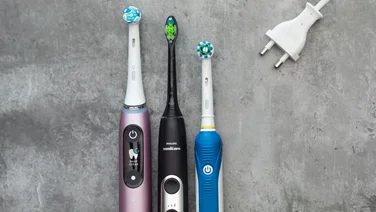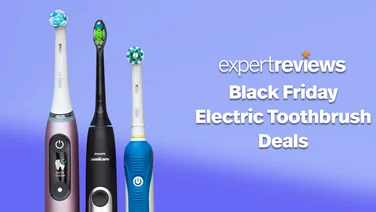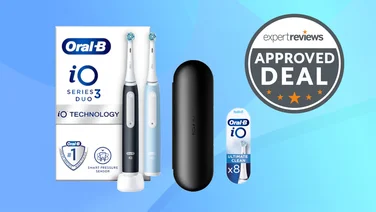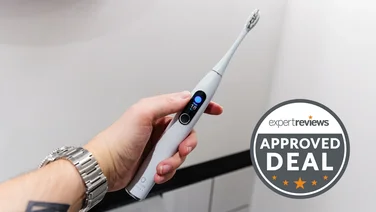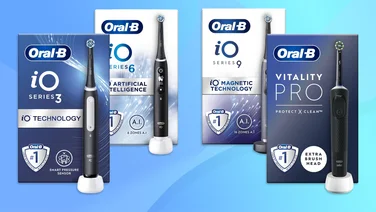To help us provide you with free impartial advice, we may earn a commission if you buy through links on our site. Learn more





- Powerful cleaning
- Quiet(er) operation
- Good range of modes
- Ridiculous price
- Atrocious battery life
- Inaccurate brush tracking
Oral-B is one of the biggest electric toothbrush brands on the market, with a wide range of brushes on offer. Brushes start at the £20 entry-level models and whizz all the way up to the all-singing, all-dancing Oral-B iO10.
Before I had the chance to review the Oral-B iO10, I was in awe of the sheer amount of stuff it claimed to do for your teeth. And, having covered electric toothbrush launches for many years, I always felt a mystique surrounding the brush and its ludicrously high price tag. Mystique, of course, in two ways: why on earth would a toothbrush need to cost this much and who in their right mind would ever buy one?
Well, over weeks of testing, I’ve developed a love-hate relationship with the Oral-B iO10. It certainly left my teeth feeling cleaner than any sonic toothbrush I’d ever used, and I loved how customisable the brush modes were. However, its battery life was one of the worst I’d encountered in a long time, and its coveted smart features were quite disappointing.
Oral-B iO10 review: What you need to know
As mentioned above, the iO10 is Oral-B’s top-of-the-range toothbrush. It currently retails for a whopping £400 but when it first came to market it had a far more outrageous price tag of £800.
Since it’s part of the iO range, it comes with the brand’s most advanced magnetic drive motors and a dual-pressure sensor that lets you know if you’re using too much or too little pressure. These motors use Oral-B’s rotary brushing motion, supposedly channelling micro-vibrations through the brush heads to provide an even more thorough clean.This more complex system requires chunkier and pricier heads than brushes in the Genius and Pro range. Currently, the cheapest standard Oral-B Cross Action heads are £18 for eight heads, while the iO heads you’ll need for this brush cost a whopping £46 for the same number of heads. Of course, that’s a huge price difference that amounts to an extra £14 per year if you replace your head every three months, as Oral-B recommends.
Aside from its cleaning abilities, the main selling points of the brush are its app-connected smart features and the seven brushing modes you can choose between. The app offers personalised brushing plans and can track the brush around your mouth as you go. It can also provide a personalised brushing plan for you, based on any dental problems you may have.
Oral-B iO10 review: Design and key features
The Oral-B iO10 has seven brush modes – daily clean, sensitive, whiten, gum care, intense, super sensitive,and tongue clean. The brush’s built-in OLED screen displays the setting you’re using and pops up with brushing feedback in the form of a smiley or sad emoji after every session. It also connects to an app on your smartphone, tracking your brushing around 16 areas of your mouth.
As far as I can tell, other than claiming to use a more advanced gyroscope to track the brush, these features are identical to those on the Oral-B iO9. The Oral-B iO10 doesn’t make any significant improvements to the brush modes, accuracy of the brush tracking or app feedback at all.





In reality, the only significant difference between the £250 iO9 and the £400 iO10 is the smart charger that comes with the latter. The brand describes this charger as “revolutionary” but I’ll shed some light on what it does so you can decide for yourself whether it helps justify the £150 price difference.
In a nutshell, the smart charger connects to your brush via Wi-Fi and displays your brushing time on a screen on the front of the device. It also uses six LED light strips arranged in a circle to symbolise the six areas of the mouth. These turn from blue to a flashing white when the area has been sufficiently cleaned. These lights also flash red and green when you’re using too little or too much pressure. It also displays the time when you aren’t brushing.
To clarify, the brush’s built-in pressure sensor already warns you about over and under pressure, and its built-in screen already displays brushing time. This renders most of the smart hub features pretty useless unless you use it to help monitor your teeth tracking.





Admittedly, the hub minimises the need for people to bring their phone to the bathroom to use the live brush tracking. However, the feedback on the smart hub is far less detailed than it is on the app (it only displays six out of the 16 brushing zones), and the hub requires you to have a two-pin plug in your bathroom. Thankfully, the brushing feedback is visible from above so it can be placed on a sink or countertop and still be visible. Using the smart hub is much less convenient if you need to charge your toothbrush elsewhere.
The other key part of an electric toothbrush is its battery life. The Oral-B iO10 uses a li-ion cell that’s wirelessly rechargeable and Oral-B claims it lasts a full two weeks. In my tests, the brush lasted 61 minutes before giving up the ghost. Divide that by the four minutes of brushing recommended per day, and you hit about 15 days between charges.
That said, brushing my teeth as thoroughly as the brush wanted me to lasted at least two and a half minutes each session. That means that, most times during real daily use, the battery life only lasted 12 days or so. When there are far cheaper Oral-B options that last 34 days and sonic brushes that can run for a whopping 90 days, this is a pretty poor performance.
Oral-B iO10 review: Performance
For all its design flaws, the Oral-B iO10 is still incredibly effective at cleaning teeth. No matter which mode I used, the brush buffed away any plaque and debris from my mouth, leaving my teeth looking shiny and polished. I could also feel a significant difference between the sensitive, daily clean and intense modes – increasing in power as I went up the scale.
The one mode I feel is slightly misleading is whitening. During testing, I felt its intense cleaning power helped to lift surface-level staining, but didn’t touch the sides of any tougher staining caused by my years of coffee drinking. That said, I can see the range of modes being useful if you’re starting out with inflamed gums and sensitive teeth – as your dental health improves, you’ll be able to increase the intensity incrementally, preventing further irritation or discomfort.
The trouble is, you get the same powerful clean from all brushes in the iO range. The entry-level iO3 only comes with three modes – daily clean, sensitive and whitening – but if your oral health is generally good, these are the only brush modes you should need.
I did enjoy the cutesy emoji brushing feedback displayed on the brush’s screen. Its responses ranged from a happy face with starry eyes – indicating brilliant brushing – to a sad crying face for when you’ve majorly skimped out on your brushing coverage and time. The brush doesn’t only greet you with a smile when you’re done brushing either, it also wishes you good morning and good night when you initially pick the brush up. On some days, the brush winked at me when it booted up for the day – hilarious, but totally unnecessary.





Sadly, though, the brush’s amicable personality couldn’t make up for its shortfalls. Mainly, the Oral-B iO10’s smart features were a major letdown. I found the brush tracking to be completely inaccurate – no matter how obvious I tried to make the brush positioning seem, it struggled to correctly register which area of the mouth I was brushing in.
In fact, when I tried to ensure perfect coverage, by the brush’s standards, I spent more time focusing on getting the brush positioning to register correctly than I did on properly brushing my teeth. That completely defeated the object of smart tracking, since it meant I overbrushed in certain areas and failed to properly cover others. After two weeks of trying to get the brush to register its position correctly, I gave up trying out of frustration. I imagine anyone else who bought the brush would do the same.
Furthermore, the app isn’t particularly useful if you already have a good dental hygiene routine. The guidance on the Oral-B app is only handy if you need a helping hand deciding which modes to use for your specific dental problems. Those looking to receive daily floss reminders on their phone may also find it useful.
Beyond that, the tailor-made brushing programmes simply sit alongside your normal brushing routine, giving you a timeframe in which to fix the problem. This is only useful as an indication, since you’ll obviously know if your gingivitis is cured when your gums stop bleeding or feeling sore, for instance. The app can’t tell you that unless you input the data yourself, which can be a slog. So, if you aren’t a stickler for data and tracking your teeth health, then the app is largely superfluous and can’t really improve your brushing unless you’re missing huge sections of your mouth every time you brush.
Oral-B iO10 review: Verdict
If my toothbrush is setting me back £400 – or a gobsmacking £800 at full price – I expect it to live up to its investment and clean my teeth flawlessly. Sadly, with its measly battery life, I could hardly get through a two-week holiday without the brush dying on me.
Thankfully, if you’re dead-set on investing in the Oral-B iO magnetic drive technology, there are options that offer far better battery life. The entry-level Oral-B iO3 lasts 34 days before it needs a recharge and it gets you all the basics including three brushing modes but skips out on the smart technology. It also costs as little as £55 when it’s on sale. To me, choosing between the two brushes is a no-brainer.
That said, if you want the versatility and analysis that the iO10 offers, then I should point you toward the Oral-B iO9 instead. That brush features identical brush modes, as well as the same measly battery life and smart features, but costs £250 on average, rather than £400. Still expensive, sure, but far better value than the iO10.


